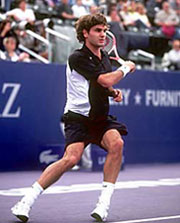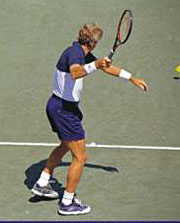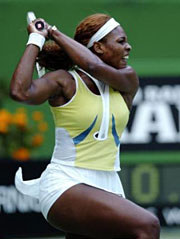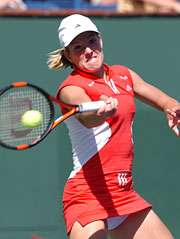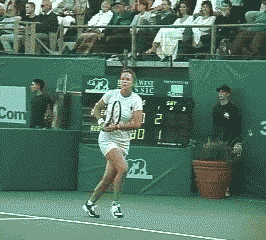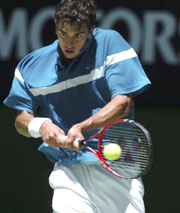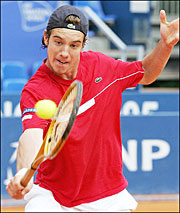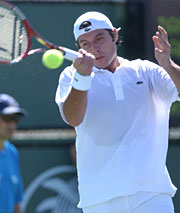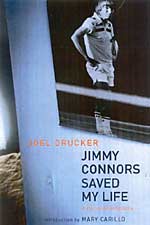|
TennisOne Features Wimbledon Preview 2005 By Joel Drucker We come now to Wimbledon. This 180-degree shift from the grinding claycourt season begs several questions worth debating that's not easy to answer: Which tournament is the best showcase for tennis? Even that's a two-pronged question: better showcase for the viewing public, or better showcase for the skills it takes to be a champion? Is it easier in today's game to teach a claycourter how to play on grass? Or the opposite? And finally, the question I ask every year: Why are these two biggies bunched so close together? I know how this evolved historically, but must we be stuck with this forever? OK, enough of these macro questions. Time for the business at hand.
Though their matches of consequence won't really start until the second week of the tournament, it's the women's field at Wimbledon this year that most engages me. While Roger Federer is the odds-on favorite to join Pete Sampras and Bjorn Borg as the only three-peaters of the last 68 years, the women's field has a wide range of contenders. The three favorites – each for drastically reasons – are, in no particular order, Maria Sharapova, Justine Henin-Hardenne, and Serena Williams. Sharapova surely loves Wimbledon. Her first appearance in 2003, a nice run to the round of 16, was a fine debut. And then last year she fought like a veteran to win the title, shocking the world when she routed Serena Williams in the final. Though she's not won a significant title this year, she's performed steadily. Wimbledon will reward her penchant for first-strike tennis. It will be interesting to see if she makes more sorties to the net – and if her nerves hold up under the newfound pressure of being the hunted instead of the hunted (tip of the hat to Martina Hingis for this pet phrase).
Four years ago – a long, long time ago in her life – Henin-Hardenne reached the Wimbledon finals. She's got the skills, but the question is if she can take charge of a point quickly enough. On clay, she's superb at forcing opponents to get into rallies just long enough for her to take the offense. There's no time for that on grass. As her coach, Carlos Rodriguez, recently told Matt Cronin of ESPN.com, “ Justine needs to serve and volley more on grass. She has to go to the net more. Everybody knows it. She knows it, too. But you can't repeat it to her every day. She has the qualities to win the tournament, but hasn't put the game in place to do it yet.” Don't expect the Belgian to become the second coming of Patrick Rafter. But certainly more approaches will accomplish the objective that makes players like Henin-Hardenne so dangerous: the ability to keep opponents off-balance.
As for Serena, well, no one can say she's lit up the tour this year (though some time ago she did snag the Australian Open). Nor is it clear if the ankle injury that forced her to withdraw from the French Open is better. Nor is there any evidence of her gaining new input, training harder or pondering new tactics. It doesn't matter. Wimbledon may be the most formal of the Slams, but it's also the most forgiving. Grass so rewards opportunism that matters of preparation, practice and diligence mean far less than aggression and one's ability to strike the big shot at the right time. Serena has built her career on this quality, and I see no reason why she shouldn't be deep in the thick at Wimbledon this year. Just below these three is a quartet of supreme skill, their chances only hindered by the slightest of liabilities. Lindsay Davenport's got the strokes, but can she close out matches and dictate play well enough given how slow she moves? Amelie Mauresmo has the tools and the wheels, but even her cornerman, Yannick Noah, admits the French have problems with the whole concept of victory. Kim Clijsters has been knocking on the door, but is she healthy physically and mentally (that round of 16 meltdown in Paris versus Davenport didn't help). And Venus Williams, once hailed as a dominant force, needs remedial technical and tactical work. Throw into this mix the moxie of Australian netrusher Alicia Molik and the powerful drive of all those Russians – Svetlana Kuznetsova, Nadia Petrova and Elena Dementieva are the ones I think have the best shot at doing at well at Wimbledon – and it promises to be an engaging women's field.
Men: Roger, Roger? Forget the calm manner. Forget the articulate way in which he discusses his wins, his life, his game, his dreams. Roger Federer right now is one cranky dude. For all the talk of him possibly being the greatest player in tennis history, for all the notions that he's already better than Pete Sampras, for all the songs that have been sung about his luscious strokes, Federer comes into Wimbledon having been bested in the semis of each of the year's first two Slams. This shouldn't happen to him on Wimbledon's grass, but there's no question he arrives in London with an exceptional sense of urgency, a belief that nothing less than a title will be satisfactory. And perhaps that urgency could blind him so much he might press more than usual – or it might inspire Federer to play the kind of sublime tennis that's made him champ at Wimbledon the last two years. My thinking is he'll attain the latter, albeit in a manner that we've rapidly come to take for granted: sweet forehands, big serves at the right moments, a smattering of clutch backhands and volleys. Take Federer and concede the field. It's second place that's up for grabs this year. That wasn't true a year ago, when Andy Roddick appeared quite likely to challenge Federer – and backed up the expectation with a strong four-set challenge in the finals. Since then, though, Roddick's growth path has been somewhat fuzzy. Tournament titles in San Jose and Houston were reasonable, as was a semifinal effort in Australia. But Roddick's failed to make much of a mark at any Tennis Masters event (OK, a semi in Indian Wells). Nor did he acquit himself with his second round loss in Paris. Committed to improvement, keenly professional and articulate, Roddick is still searching for that breakthrough series of efforts that will get him back to the top. This year's Wimbledon will be quite revealing. As for the other men at Wimbledon, it's a rather scattered table. Lleyton Hewitt's health, Marat Safin's head, Tim Henman's game: all suspect at this point, all uncertain if any of these guys have the right combination of goods to win even four matches, much less the seven it takes to win the title. Floaters lurk who have the tools but have never put together much at Wimbledon: Aussie Wayne Arthurs, he of the nasty lefty serve; his mate Mark Philippoussis, once destiny's child, hoping to make yet one more run; American Taylor Dent, who despite his desire to play a percentage attacking game is one of the more up-and-down physical packages you'll ever see; Britain's Greg Rusedski, another big lefty server but now slowing down considerably; and a whole slew of Americans – James Blake, Jeff Morrison, Mardy Fish, Robby Ginepri – who as they near their mid-20s hope indeed to prove that their best tennis lies ahead.
The players I'm most curious about at Wimbledon this year are Mario Ancic, Sebastien Grosjean and Richard Gasquet. Ancic's the last man to beat Federer at Wimbledon. Last year he beat Henman on his way to a rough-and-tumble four-set semi loss to Roddick. Tall, agile, as close to Richard Krajicek as we've got in today's game, I'd like to think Ancic can even eventually win this title. But it's disappointing to see how erratically he performs throughout the year. Grosjean's been to the semis (knocking off Henman in '03), and plays a rather eclectic mix of tennis. And Gasquet? He's the new kid on the block, yet another elegant Frenchman with his own distinctive style, including a sweet one-handed backhand. His game seems quite adaptable to all surfaces too, as evidenced when he beat Ancic at the major Wimbledon tuneup event in London. And what about the hottest man in tennis, Rafael Nadal? Unlike many of his fellow Spaniards, he's stated that Wimbledon is the tournament he wants to win most of all. Fair enough. This isn't the year for that to happen (though I could see Nadal willing himself to the round of 16). As we've seen over the recent months, Nadal gets better as the points get longer. What makes him think there'll even be a chance for him to work his magic if the point's over in three shots? Against a guy like Arthurs it's a 50-50 pick. Yet once upon a time there was another teen prodigy who won the French Open with tremendous court coverage and wicked topspin. Few figured he had the skills for grasscourt tennis. His name was Bjorn Borg. Go figure. Your comments are welcome. Let us know what you think about Joel Drucker's article by emailing us here at TennisOne .
Jimmy Connors Saved My Life: A Personal Biography Longstanding TennisOne writer Joel Drucker has just published his first book, Jimmy Connors Saved My Life: A Personal Biography. Mr. Drucker provides the most thorough examination ever attempted of one of the most complex characters in recent sports history. The book is both a comprehensive biography of the controversial tennis star and a look at how the author's life intersected and conflicted with Jimbo's. The book includes extensive analysis of Connors' tennis, including the vital impact his mother had as his primary coach, as well as the significant work the great Pancho Segura did in his formative years. Also covered are a great many of Connors' most important matches, as well as many personal interactions Drucker had with Connors that reveal unusual sides to him. |

